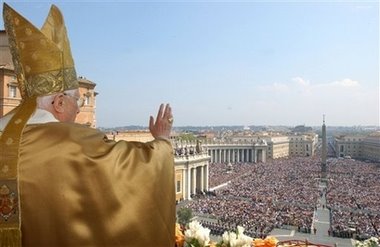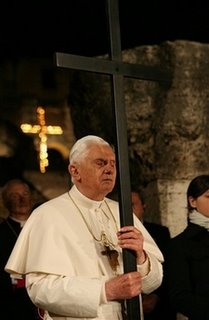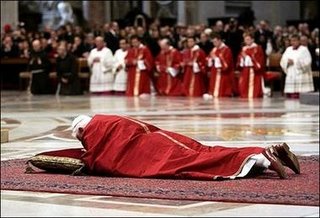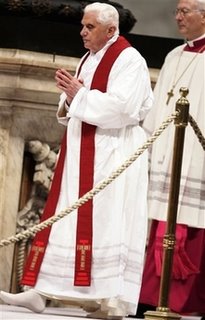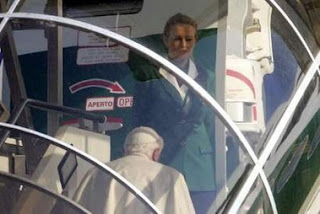
On politicians who support abortion (from the Washington Post):
The Pope was asked whether he supported Mexican Church leaders threatening to excommunicate leftist parliamentarians who last month voted to legalize abortion in Mexico City.
"Yes, this excommunication was not an arbitrary one but is allowed by Canon (church) law which says that the killing of an innocent child is incompatible with receiving communion, which is receiving the body of Christ," he said.
"They (Mexican Church leaders) did nothing new, surprising or arbitrary. They simply announced publicly what is contained in the law of the Church... which expresses our appreciation for life and that human individuality, human personality is present from the first moment (of life)."
About The Church and Latin American problems (From the Papa Ratzinger Forum):
"The Church as an institution does not do politics, we respect secularity, but the Church indicates the conditions in which social problems can be resolved....The Church's mission is religious, but it opens the way for the solution of important social problems."
About liberation theology (From the Papa Ratzinger Forum):
"There is room in the Church for a legitimate debate on how to create the conditions necessary for human liberation, how to make Church social doctrine effective, and how to indicate the social and human conditions in which the right values can grow."
He added that "The situation has changed profoundly from when liberation theology was born...It is clear that the facile millenarisms that thought they could realize a complete revolution of human life were wrong. Now everyone knows this. Ut the point is what role should the Church play inthe struggle for justice - theologians and sociologists are divided over this."
He noted that when he was at the CDF, "we tried to discern how the church could get rid of these false millenarisms and of politicization."
About El Salvador's martyr bishop Oscar Romero (From the Papa Ratzinger Forum):
"I have no doubt he will be beatified. I know that the cause is proceeding well at the Congregation for the Cause of Saints," but said he did not have precise information.
"He was certainly a great witness for the faith, a man of great Christian virtue who was committed to peace anad against dictatorship." Recalling that Romero was assassinated during the Consecration of the Host, he said it was 'an incredible death.'
On this last comment a note, for those who don't know the Greek word "martyr" means "witness" which hightlights what the pope is saying in regard to Archbishop Romero.
The Pope was asked whether he supported Mexican Church leaders threatening to excommunicate leftist parliamentarians who last month voted to legalize abortion in Mexico City.
"Yes, this excommunication was not an arbitrary one but is allowed by Canon (church) law which says that the killing of an innocent child is incompatible with receiving communion, which is receiving the body of Christ," he said.
"They (Mexican Church leaders) did nothing new, surprising or arbitrary. They simply announced publicly what is contained in the law of the Church... which expresses our appreciation for life and that human individuality, human personality is present from the first moment (of life)."
About The Church and Latin American problems (From the Papa Ratzinger Forum):
"The Church as an institution does not do politics, we respect secularity, but the Church indicates the conditions in which social problems can be resolved....The Church's mission is religious, but it opens the way for the solution of important social problems."
About liberation theology (From the Papa Ratzinger Forum):
"There is room in the Church for a legitimate debate on how to create the conditions necessary for human liberation, how to make Church social doctrine effective, and how to indicate the social and human conditions in which the right values can grow."
He added that "The situation has changed profoundly from when liberation theology was born...It is clear that the facile millenarisms that thought they could realize a complete revolution of human life were wrong. Now everyone knows this. Ut the point is what role should the Church play inthe struggle for justice - theologians and sociologists are divided over this."
He noted that when he was at the CDF, "we tried to discern how the church could get rid of these false millenarisms and of politicization."
About El Salvador's martyr bishop Oscar Romero (From the Papa Ratzinger Forum):
"I have no doubt he will be beatified. I know that the cause is proceeding well at the Congregation for the Cause of Saints," but said he did not have precise information.
"He was certainly a great witness for the faith, a man of great Christian virtue who was committed to peace anad against dictatorship." Recalling that Romero was assassinated during the Consecration of the Host, he said it was 'an incredible death.'
On this last comment a note, for those who don't know the Greek word "martyr" means "witness" which hightlights what the pope is saying in regard to Archbishop Romero.











